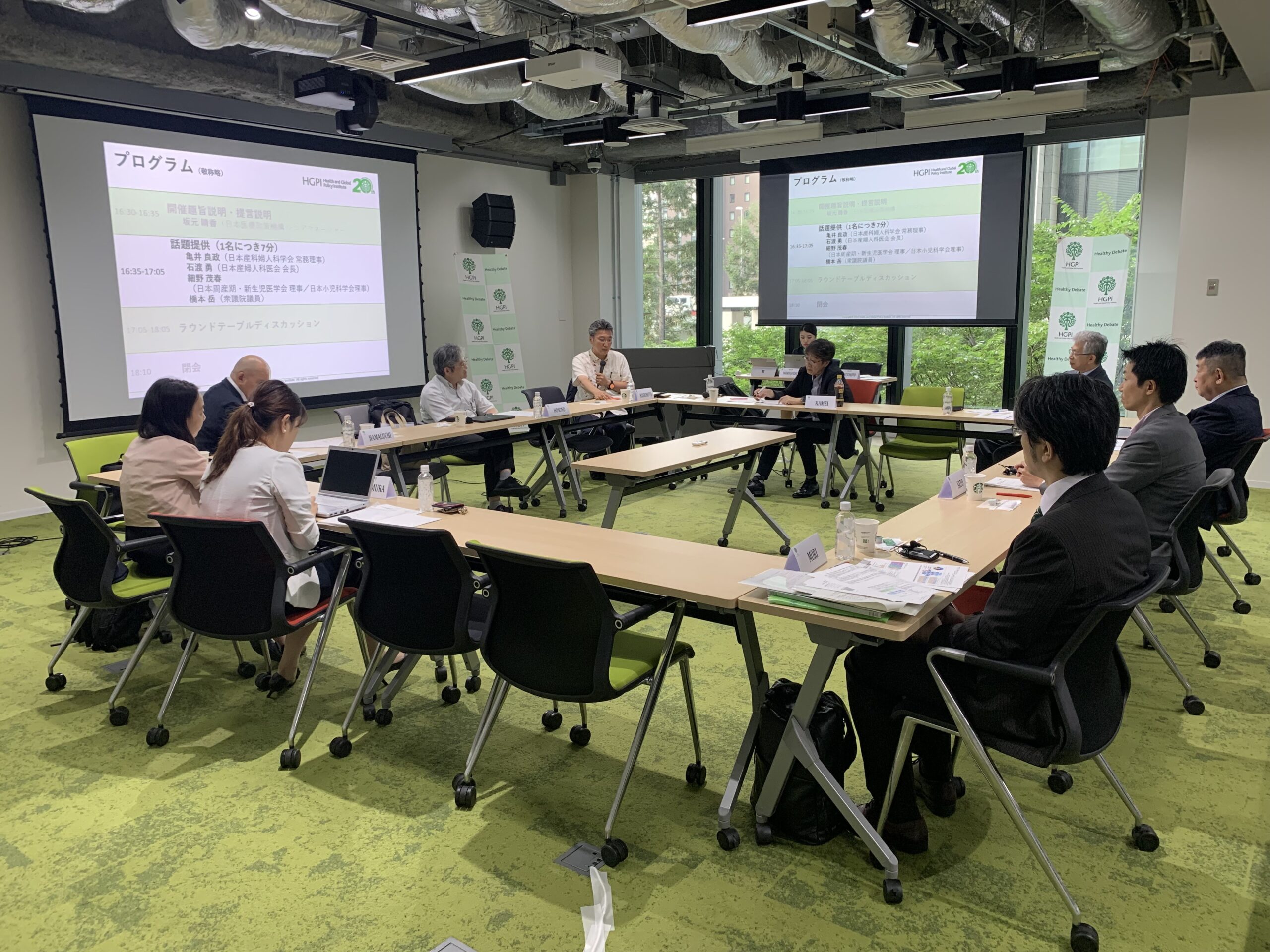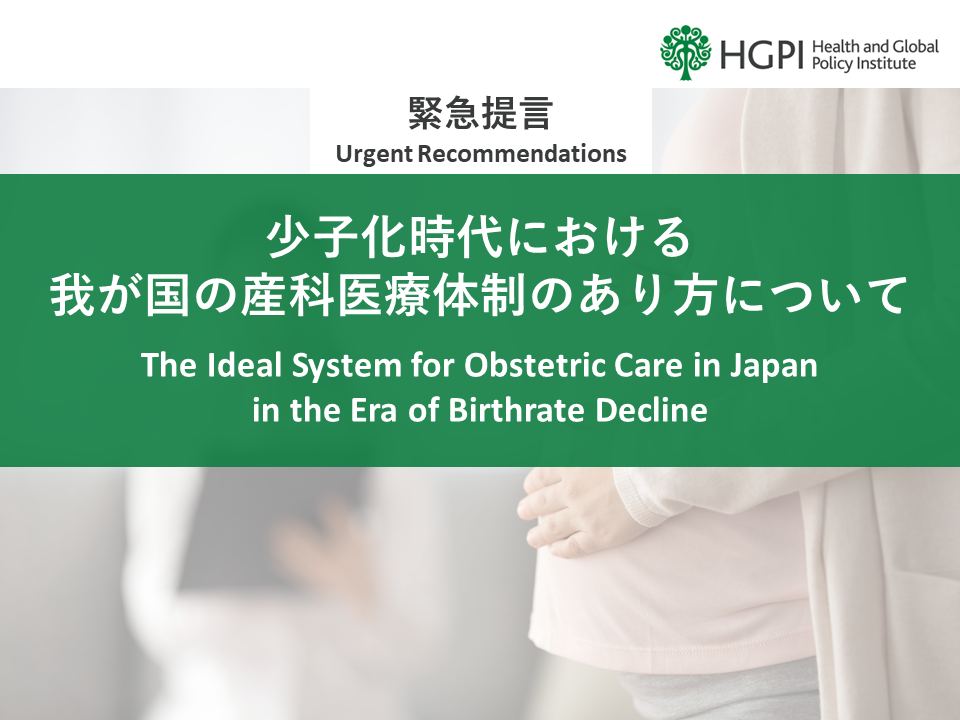[Discussion Points] Women’s Health Project Expert Meeting “The Ideal System for Perinatal Medical Care in Japan in the Era of Declining Birth Rates” (November 11, 2024)
date : 11/11/2024
Tags: Women's Health
![[Discussion Points] Women’s Health Project Expert Meeting “The Ideal System for Perinatal Medical Care in Japan in the Era of Declining Birth Rates” (November 11, 2024)](https://hgpi.org/en/wp-content/uploads/sites/2/wh-20241111-top_ENG.png)
Health and Global Policy Institute’s (HGPI) Women’s Health Project hereby announces the publication of key discussion points for to consider for future perinatal care delivery systems, based on discussions held during the expert meeting titled “The Ideal System for Perinatal Medical Care in Japan in the Era of Declining Birth Rates” on Wednesday, July 17, 2024.
At this meeting, experts gathered to discuss necessary measures in addition to current policies to maintain safe and secure perinatal care delivery systems even in an era of declining birthrates.
For details of the key discussion points, please see the PDF linked at the end of the article.
For more information about this meeting, please refer to the meeting report in the related posts.
5 Key Discussion Points
Discussion Point 1:
Various factors make it difficult to maintain Japan’s system for providing safe and secure perinatal care with the existing perinatal care system. These factors include fewer births, shortages in and aging among physicians who are responsible for delivery, especially in rural areas; the rising cost of childbirth due to rising prices for goods and higher personnel expenses, and work style reform for physicians. We must consider every possible option, including increasing the existing lump-sum childbirth and child-rearing allowance and granting insurance coverage to childbirth.Discussion Point 2:
Two goals related to financial resources for childbirth must be met: the financial burdens placed on expectant mothers and their families must be reduced; and health institutions providing perinatal care in communities must be able to operate in a sustainable manner. Achieving these two goals will require considering a broad financial support system that combines three financial resources: health insurance, public funds, and out-of-pocket payments.Discussion Point 3:
Nighttime deliveries account for about half of all deliveries. In the current system, the frequency of nighttime deliveries makes it extremely difficult to reduce the number of obstetricians on duty for deliveries while ensuring deliveries stay safe and secure. Given this unique characteristic of obstetrics, we must reconsider how to achieve the standards for overtime hours described in work style reforms for physicians.Discussion Point 4:
As the birthrate declines, one measure to be considered is the consolidation of obstetric care facilities over the medium to long term. However, consolidation places a greater burden on expectant mothers and their families the more rural the area is in which they live. As efforts to categorize health institutions by function continue to advance, careful consideration must be given to the question of how to consolidate obstetric care facilities while still maintaining the same level of care.Discussion Point 5:
Pediatricians have major roles to play before and after childbirth, such as by attending deliveries or by providing perinatal visits before deliveries. Due to birthrate decline, the sustainability of the pediatric care provision system also faces the same challenges as the system for care during the perinatal period. These challenges include the difficulty of securing financial resources and a lack of aspiring entrants to the field. We must also consider how to establish systems providing seamless care from before birth to childhood.
Top Research & Recommendations Posts
- [Research Report] Perceptions, Knowledge, Actions and Perspectives of Healthcare Organizations in Japan in Relation to Climate Change and Health: A Cross-Sectional Study (November 13, 2025)
- [Research Report] The 2025 Public Opinion Survey on Healthcare in Japan (March 17, 2025)
- [Policy Recommendations] Developing a National Health and Climate Strategy for Japan (June 26, 2024)
- [Policy Recommendations] Mental Health Project: Recommendations on Three Issues in the Area of Mental Health (July 4, 2025)
- [Research Report] The 2023 Public Opinion Survey on Satisfaction in Healthcare in Japan and Healthcare Applications of Generative AI (January 11, 2024)
- [Announcement] HGPI Endorses the “Belém Health Action Plan” (November 14, 2025)
- [Publication Report] Planetary Health Promotion Project “Issues Facing Planetary Health and the Role of the Health Sector” (May 10, 2023)
- [Announcement] HGPI Joins Global Green and Healthy Hospitals (August 1, 2023)
- [Research Report] Survey of Japanese Physicians Regarding Climate Change and Health (December 3, 2023)
- [Public Comment Submission] “Interim Evaluation of the Implementation Status of the National Biodiversity Strategy 2023-2030 (Draft)” and the “7th National Report under the Convention on Biological Diversity (Draft)” (December 2, 2025)
Featured Posts
-
2025-12-11
[Event Report] Core Components of Universal Health Coverage (UHC): Achieving “Healthcare Without Financial Hardship” in Asia-Pacific and Japan (December 5, 2025)
![[Event Report] Core Components of Universal Health Coverage (UHC): Achieving “Healthcare Without Financial Hardship” in Asia-Pacific and Japan (December 5, 2025)](https://hgpi.org/en/wp-content/uploads/sites/2/HGPI_20251210_Core-Components-of-Universal-Health-CoverageUHC-top.jpg)
-
2025-12-12
[Registration Open] Meaningful Involvement Promotion Project Urgent Symposium “The New Takaichi Administration and Central Social Insurance Medical Council Reform – Ensuring Patients’ Voices are Heard” (January 22, 2026)
![[Registration Open] Meaningful Involvement Promotion Project Urgent Symposium “The New Takaichi Administration and Central Social Insurance Medical Council Reform – Ensuring Patients’ Voices are Heard” (January 22, 2026)](https://hgpi.org/en/wp-content/uploads/sites/2/HGPI_20251208_urgent-symposium-1.png)
-
2025-12-12
[Registration Open] (Webinar) The 140th HGPI Seminar “Early Detection to Reduce COPD Disease Burden: Connecting Clinical Frontiers with Health Policy” (January 27, 2026)
![[Registration Open] (Webinar) The 140th HGPI Seminar “Early Detection to Reduce COPD Disease Burden: Connecting Clinical Frontiers with Health Policy” (January 27, 2026)](https://hgpi.org/en/wp-content/uploads/sites/2/hs140-top.png)







